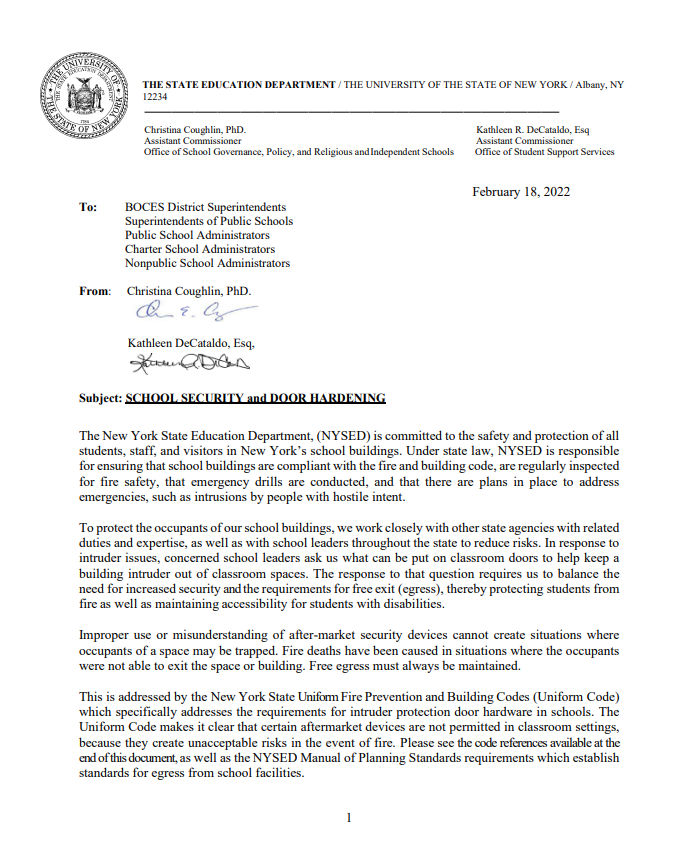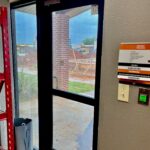
Some types of classroom barricade devices may impede egress, prevent access by emergency responders, and violate the ADA. Most classroom doors already have locks. Use them.
On Tuesday I wrote a follow-up post about a Michigan law that will allow classroom barricade devices to be used on doors serving assembly spaces (like gymnasiums, cafeterias, and theaters) in addition to classrooms. When the media publicizes the use of non-code-compliant security in a particular school district or jurisdiction, it’s easy to jump to the conclusion that this must be a good idea. It’s not.
Andy Lindenberg of Allegion sent me the memo below, from the New York State Education Department. This document was sent to all school superintendents and other school administrators in the state, clearly outlining the policies for the state’s schools and the reasons for the education department’s position. Suggested solutions are included as well, and on the third page there is a link to the Partner Alliance for Safer Schools (PASS) page for resources related to classroom barricade devices.
When looking at the policies for these two states – Michigan and New York – the difference between the two is striking. In Michigan, the state legislative process seems to have overridden the adopted state building code and fire code, and the accessibility standards – including the federal Americans With Disabilities Act (ADA). The security solutions allowed in New York schools are compliant with the adopted codes and standards, including the ADA. Is safety less important in one state than the other? Are egress, fire protection, and accessibility more important in one state than the other? Why are these states’ policies so different?
I hope you will read the memo below and refer to it as an example of how to properly balance school safety and security. Code-compliant locks are readily available, and it is not necessary to compromise safety or accessibility in favor of security. Lock the door. Period.
You need to login or register to bookmark/favorite this content.







So is the solution to Michigan’s approach to initiate ADA suits on a district-by-district basis? Sort of sad to have to make them use money to defend a suit, where they could have just installed proper classroom locks instead.
If Michigan were California, there would already be a dozen legal practices gearing up.
Hi Joel –
Part of the problem with the ADA lawsuits is that if the classroom barricade is a type that is not permanently attached to the door, technically the ADA law does not apply. So a school could have devices that are not operable with one hand, or not without tight grasping, pinching, or twisting of the wrist, and/or are mounted outside of the 34-48 inch range (or 34-44 in California)…in other words, devices that can not be operated by someone with a disability…and they would be outside of the purview of the law.
And you’re right about California – a while back, a California college was forced to remove 1,000 barricade devices they had purchased for more than $200,000: https://idighardware.com/2018/02/ff-state-to-city-college-uninstall-1000-fire-code-defying-barricade-devices/
– Lori
As a Michigan resident, i can attest to the rush by parents and school boards to try “any means necessary” approach to stop these incidents from leading to more fatalities.
I’ve had heated discussions with irate parents who don’t understand the consequences that can occur when some of these devices are implemented and insist on their use regardless of Codes or Laws.
I am also upset by State representatives who fail to use their positions to do the right things to stop these rogue groups from overpowering local school boards across the state.